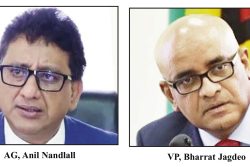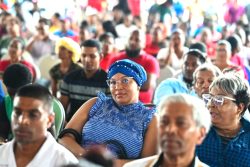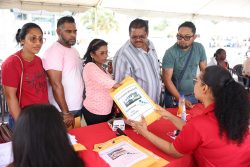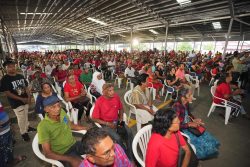Preparations for the second staging of the Guyana Trade and Investment Exhibition (GuyTIE), having been pushed forward from the month of March to allow for a clear gap between the March 2 general elections and the event itself, will, presumably, begin in earnest shortly. One makes this point conscious of the proclivity for events of this nature not being afforded sufficient time and attention for the kind of detailed and meticulous planning necessary for their success. The month of May, the organisers must remind themselves, is no more than a stone’s throw away.
One assumes that the planners of GuyTIE II have been taking account of lessons from its predecessor and there were quite a few of those, some of which this newspaper was fortunate enough to get an opportunity to discuss with the planners of the forthcoming event with a degree of frankness.
One of the issues that arose during that exchange had to do with whether or not anywhere near sufficiently serious effort had been put into getting potential investors, particularly from North America and Europe, to travel to Guyana for GuyTIE. That issue arose out of the GuyTIE I experience of us (as far as this newspaper is aware) being unable to attract a single potential investor or buyer from North America or Europe. Notwith-standing the fact that this can be considered a major disappointment, to say the least, our discussion with some of the key people involved in the planning of GuyTIE II left us with the impression that they were mindful of the shortcomings of the previous event and of the need for corrective measures.
Some things that warrant mention have changed since GuyTIE I, the most significant of these being the continually unfolding story of Guyana’s oil & gas industry and the impact that this has had on the global attention now accruing to Guyana. Hope-fully, that in itself, will be a sort of involuntary marketing asset for GuyTIE II with potential investors and buyers now feeling that there are good reasons to visit Guyana at this time.
This, mind you, is no reason for us to be slovenly in our approach to preparing a time-lined plan that allows sufficient room for the effective execution of GuyTIE II.
We learnt quite recently that some amount of training and sensitisation has already been undertaken with the purpose of better-equipping local participants to sell their enterprises and their products to the overseas business representatives that are expected to be here for GuyTIE II. Here it is apposite to comment again (we have done so previously) on the excellent showing made by those local small and medium-scale enterprises (SMEs) mobilised for GuyTIE I by the Small Business Bureau, the outcomes of which included some measure of attention from business interests in Canada and parts of the Caribbean.
If one expects that GuyTIE will again seek to attract the attention of the major players, particularly manufacturers in the private sector, there is no question that the creditable showing of SMEs at GuyTIE I more than warrants a ‘second coming’ for them and in that regard there is every reason to embrace the Small Business Bureau and its CEO, Dr Lowell Porter, as an integral part of the planning exercise on the domestic side.
Taking our cue from the disappointments of GuyTIE I, the Stabroek Business firmly believes that the bulk of the effort to make GuyTIE II an improvement on its predecessor has to be dedicated to getting potential investors and buyers to come to Guyana. If this will, in all likelihood, involve some amount of overseas travel for the specialists involved in the planning, travel ought not to be seen as a ‘joy ride’ for hand-picked functionaries. Delegations, small ones, hopefully, picked to travel abroad to help persuade foreign business enterprises that there is potential benefit for them from being in Guyana for GuyTIE II ought to include the best and most disciplined negotiators we can find. These must be single-mindedly seized of the purpose of their travel. Here, too, is an opportunity to trot out those much talked-about economic diplomacy skills by throwing some of our overseas-based diplomats (who would, presumably, possess some measure of familiarity with their ‘local’ turf) into the lobbying effort to get targeted businesses from North America and Europe, particularly, to be here for GuyTIE II.
Contextually, one wonders aloud as to whether, first, there is an ongoing interface occurring between the GuyTIE planners and Takuba Lodge regarding GuyTIE II and whether our diplomatic missions abroad, particularly those at post in countries from which participation in GuyTIE is being sought, are being continually briefed on what kinds of support are required of them.
With marketing Guyana abroad certain to be one of the key pursuits at the level of both government and the private sector, going forward, we have not, over time, done nearly sufficient to develop a cadre of highly trained local functionaries (at the levels of both the public and private sector) who can sell Guyana effectively. Part of the problem reposes in the fact that marketing Guyana abroad in the conventional sense has not, traditionally, been considered a public sector function, which is part of the reason why the implementation of an economic diplomacy regime where the function of ‘selling’ Guyana abroad in the business sense, is still not anywhere near embedded in the work of our overseas missions. That has to change. The job of effectively marketing Guyana abroad can only be done within a clearly defined economic diplomacy framework that includes, of necessity, a cadre of trained specialists who, frankly, do not necessarily need to be burdened with the sometimes overdone trappings of career diplomats (except, of course, for the formal accreditation, without which access to target audiences become difficult, often impossible) since much of what is required to wear that title can sometimes become superfluous when it comes down to marketing Guyana abroad. In other words there has emerged a serious need for a redefining of the very purpose of our wider diplomatic effort in order to determine, in our present circumstances, whether a re-arrangement of priorities has not now become almost an emergency.
Finally, we need, in the shortest possible time, some profound disclosure from the GuyTIE secretariat as to just where we are in terms of the May deadline since it is important that we avoid the danger of GuyTIE II not being a discernable improvement on its predecessor.









